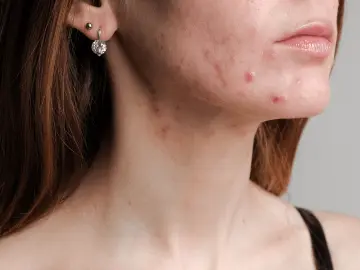It’s an unfortunate fact that for many people, acne and the pain and embarrassment that it brings with it isn’t always left behind with their teenage years.
Adult acne is a problem that affects people well into their thirties, forties and even fifties, so much so that it has been studied by dermatologists at the University of Alabama.
The study, which took place in 2007 and featured 1013 men and women age 20 and older, found that the common skin problem not only affects people of all ages, but that later in life, the condition actually affects more women than men.
While during the teenage years 68.5% of male participants and 68.8% of female participants reported having acne, these figures became considerably more disparate during later life.
This common medical condition can have a significant adverse impact on sufferers’ quality of life. Not only is it often painful, acne can cause great embarrassment and distress and have negative effect on self-esteem. That’s why we at Save Face have put together a guide on dealing with adult acne, giving you the chance to find out how to get rid of spots and the stress that they cause.
How to Deal With Adult Acne
If you do suffer from adult acne, dermatologists recommend washing affected areas twice a day with mild soap and water, as vigorous washing and scrubbing can irritate the condition and make it worse. They also recommend seeking treatment as soon as you realise the condition is not responding to over-the-counter medications such as Benzoyl Peroxide and Azelaic Acid.
Doctors will likely prescribe topical antibiotics which will kill bacteria on the skin and reduce redness and inflammation, or topical retinoids which work to reduce the production of sebum in the skin preventing the blockage of hair follicles. Oral antibiotics can also be prescribed by GPs, while stronger treatments for severe acne can only be prescribed by dermatologists.
Dermatologists also recommend that sufferers of adult acne should try to use ‘noncomedogenic’ cosmetics and toiletries, which won’t clog pores, as well as avoiding the use of oil-based cosmetics and sunscreens. Most importantly, it’s vital not to pop, squeeze or pick at the spots, to prevent scarring. Always use prescribed treatments as directed, and give products a chance to take effect, this can be a minimum of 6-12 weeks.
Non-Surgical Cosmetic Procedures
In addition to the more traditional methods mentioned above, there are a number of non-surgical cosmetic procedures that can help with both the symptoms and effects of adult acne.
How to Get Rid of Spots
The symptoms of adult acne, the spots themselves, can be effectively treated with blue light therapy, which works by killing the bacteria that causes them. In addition to blue lighttherapy, chemical peels have also been suggested as a useful treatment for acne. They work by managing the over secretion of sebum and chemically exfoliating the top layer of skin to clear pores, reducing inflammation, sebum secretion and the build-up of dead skin cells. Good skin care products designed for problem skins can support more ‘first line’ treatments and help manage the problem in the longer term.
How to Get Rid of Scarring
As well as the actual symptoms of acne, the aftermath of acne-related spots can be equally distressing, as a significant proportion of acne sufferers are affected by scarring.
Acne scars tend to appear as indentations or craters in the skin, and are caused by a loss of tissue from squeezing or picking spots. Thankfully, procedures such as laser resurfacing, medical needling, and dermal fillers can all go a long way towards improving the appearance of acne scars.
Ablative treatments such as laser or dermabrasion work by literally ‘resurfacing’ the skin, removing scar tissue and promoting the production of collagen which improves the texture of the skin.
Medical needling also works to stimulate the production of collagen in the skin by causing micro-injuries, and dermal fillers work by ‘filling in’ acne scars in order to reduce their appearance.
Save Face
At Save Face, we’ve made it our mission to make sure that anyone seeking non-surgical cosmetic procedures is fully informed about the treatments they are interested in.
Factsheets on all of the procedures mentioned above are available to download on our information page, while further information on treating both acne and other types of scarring can be found in our blog post ‘How to Get Rid of Scars’.
Once you’ve answered any questions you might have, Save Face can connect you with a fully qualified Save Face Accredited Practitioner who has been individually assessed against our stringent set of standards. Use our multifaceted search engine today and make sure that you get the best treatment available.


